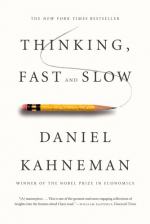
|
| Name: _________________________ | Period: ___________________ |
This quiz consists of 5 multiple choice and 5 short answer questions through Chapters 30 - 34.
Multiple Choice Questions
1. Who wrote that "chances of rare events (such as the burst of housing bubbles) receive less impact than they deserve according to their objective probabilities" (639)?
(a) John Gottman.
(b) Craig Fox.
(c) Jim Collins and Jerry I. Porras.
(d) Ralph Hertwig and Ido Erev.
2. What term refers to the quality of being noticeable or important?
(a) Salience.
(b) Endowment.
(c) Heuristic.
(d) Articulate.
3. Whom from the University of Chicago asked people to price sets of dinnerware in order to examine joint evaluation?
(a) Max Bazerman.
(b) Christopher Hese.
(c) Gary Klein.
(d) John List.
4. What statistician illustrated the ease with which people see patterns where none exist?
(a) Larry Jacoby.
(b) Christopher Chabris.
(c) William Feller.
(d) Eckhard Hess.
5. In conducting their wheel of fortune study, Kahneman and Tversky set their wheel to only stop on what numbers?
(a) 10 or 65.
(b) 12 or 98.
(c) 4 or 89.
(d) 13 or 16.
Short Answer Questions
1. In the example where the author presents two candidates for a college professorship, which individual is described as recently completing her graduate work?
2. Who was the anesthesiologist who intervened regarding physicians' and midwives' clinical judgment to determine whether a baby faced breathing distress?
3. With what economist did Kahneman and Thaler work closely in Vancouver?
4. When the author demonstrates enlisting cognitive ease when writing, he gives two statements about Adolf Hitler. Which of these statements APPEARED to be the most legitimate?
5. What part of the brain has a primary role as its threat center?
|
This section contains 267 words (approx. 1 page at 300 words per page) |

|




